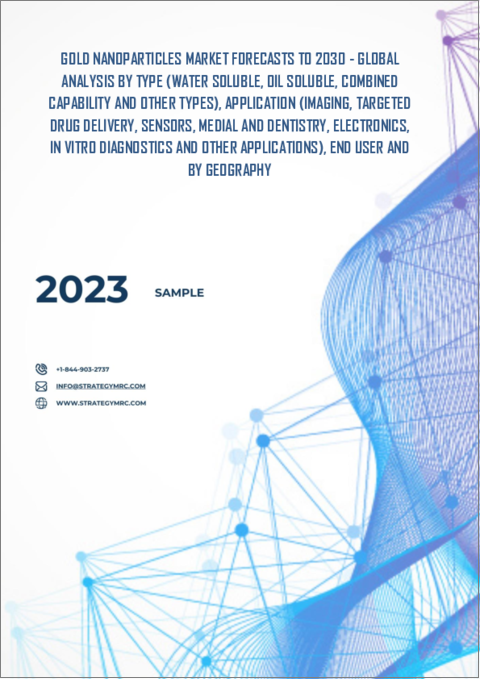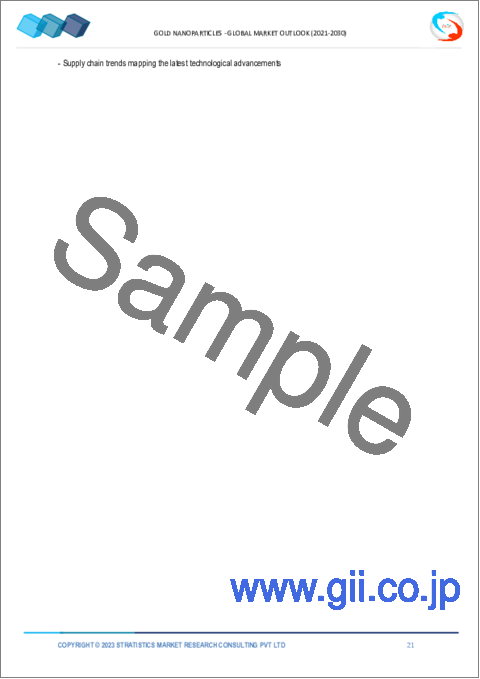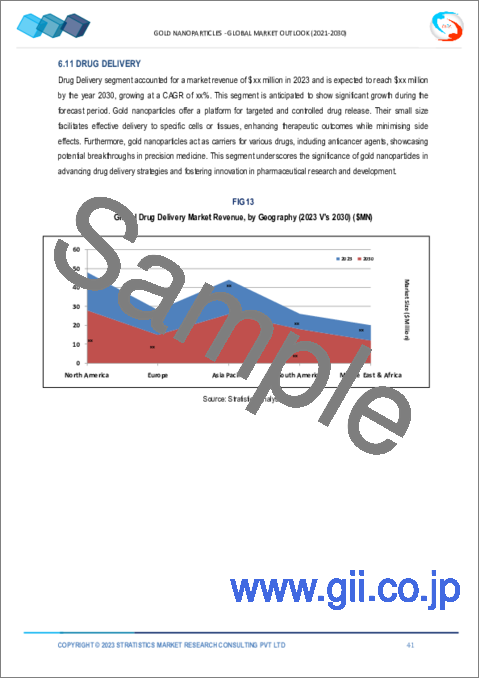|
|
市場調査レポート
商品コード
1383466
金ナノ粒子市場の2030年までの予測:タイプ、用途、エンドユーザー、地域別の世界分析Gold Nanoparticles Market Forecasts to 2030 - Global Analysis By Type, Application, End User and by Geography |
||||||
カスタマイズ可能
|
|||||||
| 金ナノ粒子市場の2030年までの予測:タイプ、用途、エンドユーザー、地域別の世界分析 |
|
出版日: 2023年11月01日
発行: Stratistics Market Research Consulting
ページ情報: 英文 200+ Pages
納期: 2~3営業日
|
- 全表示
- 概要
- 図表
- 目次
Stratistics MRCによると、世界の金ナノ粒子市場は2023年に38億1,000万米ドルを占め、予測期間中にCAGR 14.6%で成長し、2030年には98億9,000万米ドルに達する見込みです。
金ナノ粒子は汎用性が高く、広く研究されているナノ材料であり、典型的なサイズは1~100ナノメートルです。サイズや形状に依存した鮮やかな色彩など、そのユニークな光学特性は、イメージング、薬物送達、医療診断に有用です。標的治療やバイオセンサーを可能にする生体適合性により、これらのナノ粒子は高く評価されています。
米国材料試験協会(ASTM international 2006)によると、ナノ粒子とは、2次元以上の次元を持ち、1~100nmの大きさの粒子を指します。
高まる環境への懸念
金ナノ粒子は、大気汚染や水質汚染といった環境への懸念が大きくなるにつれて人気が高まっています。金ナノ粒子は、大気汚染モニタリングや水質浄化など、多くの環境アプリケーションに使用されています。さらに、汚染物質の分解を触媒する金ナノ粒子の能力と、環境毒素検出センサーへの応用は、環境保護と持続可能性への世界の焦点と一致しています。
高い生産コスト
原材料費、エネルギー使用量、合成技術の難易度は、金ナノ粒子の製造コストに影響を与える変数の一部です。製造コストが高くなるのは、特殊な用途ではサイズや形状を正確に制御する必要があるためです。さらに、大量生産において品質と粒度分布の一貫性を維持することは技術的に困難であるため、規模の経済を達成することが難しい場合もあります。コストに敏感な産業や用途での採用は、このコスト要因によって制限される可能性があります。
医療分野での発展
金ナノ粒子を使った医療分野には多くの可能性があります。その特殊な性質を利用すれば、標的を絞って薬剤を送達することができるため、正確で副作用の少ないドラッグデリバリーが可能になります。また、病気の早期診断や発見、特に感染症やがんの診断に有用な器具でもあります。さらに、金ナノ粒子は、治療効果や診断精度を高めることで、医学研究が進むにつれてヘルスケアを完全に変える可能性を秘めています。
異なるナノ材料との競争
金ナノ粒子にとっての大きな競合の脅威の一つは、同等以上の特性を持ちながら低価格の代替ナノ材料の開発です。さらに、量子ドット、銀ナノ粒子、炭素ベースのナノ材料のような材料は、消費者の需要を変える可能性があるため、企業は常に新しいアイデアを考え出し、金ナノ粒子の特別な利点をアピールし続けなければならないです。
COVID-19の影響:
金ナノ粒子の市場は、COVID-19の大流行によって様々な影響を受けています。一方では、ワクチンデリバリーや診断などの医療・診断用途における金ナノ粒子の需要の増加により市場は成長していました。金ナノ粒子の市場は、パンデミックが去った後も、特に環境産業やヘルスケア産業で拡大すると予想されます。ただし、サプライチェーンの弱点や経済の予測不可能性には注意が必要です。
ドラッグデリバリー分野が予測期間中最大となる見込み
ドラッグデリバリー分野が市場で最大のシェアを占めると予想されます。金ナノ粒子の特殊な性質により、ドラッグデリバリー用途で非常に人気があります。治療薬は、これらのナノ粒子を設計することによって、特定の細胞や組織に正確に送達することができます。金ナノ粒子の表面を機能化することで、生体適合性を向上させ、血流循環を長くすることが可能です。さらに、サイズや形状を調整できるため、特定の治療ニーズに合わせてカスタマイズすることもできます。
予測期間中、バイオテクノロジー企業セグメントのCAGRが最も高いと予想されます。
金ナノ粒子市場において、CAGRが最も高いセグメントはバイオテクノロジー企業です。金ナノ粒子は、ドラッグデリバリー、イメージング、診断、治療などのバイオテクノロジー用途でますます普及しています。金ナノ粒子は、その特殊な光学的、熱的、電気的特性により、バイオメディカル用途での使用に理想的です。さらに、金ナノ粒子を特定のリガンドや生体分子で機能化することにより、標的ドラッグデリバリーやイメージングにおける金ナノ粒子の可能性をさらに高めることができます。
最大のシェアを持つ地域
米国とカナダを含む北米が、金ナノ粒子市場で最大のシェアを占めています。この地域は材料科学、ヘルスケア、ナノテクノロジーにおける研究開発が盛んであるため、市場での存在感が強いです。さらに、金ナノ粒子の需要は、北米の研究機関、製薬会社、バイオテクノロジー企業の努力によって大きく伸びています。
CAGRが最も高い地域:
金ナノ粒子市場では、欧州地域のCAGRが最も高くなると予想されています。さらに、金ナノ粒子はイメージング、ドラッグデリバリー、診断など幅広い用途があり、ヘルスケアとバイオテクノロジー研究におけるこれらの開発が、この注目すべき成長の源となっています。ナノテクノロジー研究への強力な支援と技術革新への献身により、欧州は市場拡大を牽引する立場にあります。
無料のカスタマイズサービス:
本レポートをご購読のお客様には、以下の無料カスタマイズオプションのいずれかをご利用いただけます:
- 企業プロファイル
- 追加市場プレイヤーの包括的プロファイリング(3社まで)
- 主要企業のSWOT分析(3社まで)
- 地域セグメンテーション
- 顧客の関心に応じた主要国の市場推計・予測・CAGR(注:フィージビリティチェックによる)
- 競合ベンチマーキング
- 製品ポートフォリオ、地理的プレゼンス、戦略的提携に基づく主要企業のベンチマーキング
目次
第1章 エグゼクティブサマリー
第2章 序文
- 概要
- ステークホルダー
- 調査範囲
- 調査手法
- データマイニング
- データ分析
- データ検証
- 調査アプローチ
- 調査ソース
- 1次調査ソース
- 2次調査ソース
- 前提条件
第3章 市場動向分析
- 促進要因
- 抑制要因
- 機会
- 脅威
- アプリケーション分析
- エンドユーザー分析
- 新興市場
- 新型コロナウイルス感染症(COVID-19)の影響
第4章 ポーターのファイブフォース分析
- 供給企業の交渉力
- 買い手の交渉力
- 代替品の脅威
- 新規参入業者の脅威
- 競争企業間の敵対関係
第5章 世界の金ナノ粒子市場:タイプ別
- 金ナノ粒子ベースのドラッグデリバリーシステム
- PEG化金ナノ粒子
- 金ナノシェル
- 金ナノ粒子ベースの造影剤
- その他のタイプ
第6章 世界の金ナノ粒子市場:用途別
- センサー
- 光温熱療法
- エレクトロニクス
- 創傷治癒
- 化粧品
- ナノ流体
- 食品業界
- テキスタイル
- 水の浄化
- ドラッグデリバリー
- その他の用途
第7章 世界の金ナノ粒子市場:エンドユーザー別
- 製薬会社
- 病院と診療所
- 研究機関
- バイオテクノロジー企業
- 歯科医院
- 動物病院
- その他のエンドユーザー
第8章 世界の金ナノ粒子市場:地域別
- 北米
- 米国
- カナダ
- メキシコ
- 欧州
- ドイツ
- 英国
- イタリア
- フランス
- スペイン
- その他欧州
- アジア太平洋地域
- 日本
- 中国
- インド
- オーストラリア
- ニュージーランド
- 韓国
- その他アジア太平洋地域
- 南米
- アルゼンチン
- ブラジル
- チリ
- その他南米
- 中東とアフリカ
- サウジアラビア
- アラブ首長国連邦
- カタール
- 南アフリカ
- その他中東とアフリカ
第9章 主な発展
- 契約、パートナーシップ、コラボレーション、合弁事業
- 買収と合併
- 新製品の発売
- 事業拡大
- その他の主要戦略
第10章 企業プロファイル
- NanoComposix
- Agilent Technologies Inc.
- Expedeon Ltd.
- BBI Solutions
- NanoHybrids Inc
- Meliorum Technologies Inc
- Cline Scientific
- Nanopartz Inc
- Goldsol Inc
- Abcam plc
- Merck Group
- Cytodiagnostics Inc
- Nanosphere Inc
- Metalor Technologies International
- Solaris Nanosciences Corporation
- Sigma-Aldrich
- Tanaka Holdings Co., Ltd
- Sona Nanotech Inc
- Strem Chemicals Inc.
List of Tables
- Table 1 Global Gold Nanoparticles Market Outlook, By Region (2021-2030) ($MN)
- Table 2 Global Gold Nanoparticles Market Outlook, By Type (2021-2030) ($MN)
- Table 3 Global Gold Nanoparticles Market Outlook, By Gold Nanoparticle-Based Drug Delivery Systems (2021-2030) ($MN)
- Table 4 Global Gold Nanoparticles Market Outlook, By Pegylated Gold Nanoparticles (2021-2030) ($MN)
- Table 5 Global Gold Nanoparticles Market Outlook, By Gold Nanoshells (2021-2030) ($MN)
- Table 6 Global Gold Nanoparticles Market Outlook, By Gold Nanoparticle-Based Contrast Agents (2021-2030) ($MN)
- Table 7 Global Gold Nanoparticles Market Outlook, By Other Types (2021-2030) ($MN)
- Table 8 Global Gold Nanoparticles Market Outlook, By Application (2021-2030) ($MN)
- Table 9 Global Gold Nanoparticles Market Outlook, By Sensors (2021-2030) ($MN)
- Table 10 Global Gold Nanoparticles Market Outlook, By Photothermal Therapy (2021-2030) ($MN)
- Table 11 Global Gold Nanoparticles Market Outlook, By Electronics (2021-2030) ($MN)
- Table 12 Global Gold Nanoparticles Market Outlook, By Wound Healing (2021-2030) ($MN)
- Table 13 Global Gold Nanoparticles Market Outlook, By Cosmetics (2021-2030) ($MN)
- Table 14 Global Gold Nanoparticles Market Outlook, By Nanofluids (2021-2030) ($MN)
- Table 15 Global Gold Nanoparticles Market Outlook, By Food Industry (2021-2030) ($MN)
- Table 16 Global Gold Nanoparticles Market Outlook, By Textiles (2021-2030) ($MN)
- Table 17 Global Gold Nanoparticles Market Outlook, By Water Purification (2021-2030) ($MN)
- Table 18 Global Gold Nanoparticles Market Outlook, By Drug Delivery (2021-2030) ($MN)
- Table 19 Global Gold Nanoparticles Market Outlook, By Other Applications (2021-2030) ($MN)
- Table 20 Global Gold Nanoparticles Market Outlook, By End User (2021-2030) ($MN)
- Table 21 Global Gold Nanoparticles Market Outlook, By Pharmaceutical Companies (2021-2030) ($MN)
- Table 22 Global Gold Nanoparticles Market Outlook, By Hospitals and Clinics (2021-2030) ($MN)
- Table 23 Global Gold Nanoparticles Market Outlook, By Research Institutions (2021-2030) ($MN)
- Table 24 Global Gold Nanoparticles Market Outlook, By Biotechnology Companies (2021-2030) ($MN)
- Table 25 Global Gold Nanoparticles Market Outlook, By Dental Clinics (2021-2030) ($MN)
- Table 26 Global Gold Nanoparticles Market Outlook, By Veterinary Clinics (2021-2030) ($MN)
- Table 27 Global Gold Nanoparticles Market Outlook, By Other End Users (2021-2030) ($MN)
Note: Tables for North America, Europe, APAC, South America, and Middle East & Africa Regions are also represented in the same manner as above.
According to Stratistics MRC, the Global Gold Nanoparticles Market is accounted for $3.81 billion in 2023 and is expected to reach $9.89 billion by 2030 growing at a CAGR of 14.6% during the forecast period. Gold nanoparticles are a versatile and widely studied nanomaterial, with typical sizes ranging from 1 to 100 nanometers. Their unique optical characteristics, such as their size- and shape-dependent vivid colors, make them useful for imaging, medication delivery, and medical diagnostics. Due to their biocompatibility, which enables targeted treatments and biosensors, these nanoparticles are highly valued.
According to American Society for Testing and Materials (ASTM international 2006), nanoparticles are those particles which have two or more than two dimensions and are in the size range of 1 - 100 nm.
Market Dynamics:
Driver:
Growing Concerns about the Environment
Gold nanoparticles are becoming more popular as environmental concerns-such as air and water pollution-get bigger. They are used in a number of environmental applications, including air pollution monitoring and water purification. Moreover, the ability of gold nanoparticles to catalyze the breakdown of pollutants and their application in environmental toxin detection sensors are in line with the global focus on environmental protection and sustainability.
Restraint:
High production expenses
The cost of raw materials, energy usage, and the difficulty of synthesis techniques are some of the variables that affect the cost of producing gold nanoparticles. Higher production costs result from the need for precise control over size and shape in specialized applications. Furthermore, it can be difficult to achieve economies of scale because it can be technically difficult to maintain consistency in quality and size distribution at higher volumes. Their adoption in cost-sensitive industries and applications may be restricted by this cost factor.
Opportunity:
Developments in medicine
There are a lot of opportunities in the field of medicine with gold nanoparticles. Their special qualities can be used to deliver drugs with precision and fewer side effects by allowing for targeted delivery. They are also useful instruments for early illness diagnosis and detection, particularly in the diagnosis of infectious diseases and cancer. Additionally, gold nanoparticles have the potential to completely transform healthcare as medical research progresses by increasing treatment efficacy and diagnostic precision.
Threat:
Rivalry with different nanomaterials
One major competitive threat to gold nanoparticles is the development of substitute nanomaterials with comparable or better properties but at a lower price. Moreover, materials like quantum dots, silver nanoparticles, and carbon-based nanomaterials can change consumer demand, which forces businesses to keep coming up with new ideas and showcasing the special benefits of gold nanoparticles.
COVID-19 Impact:
The market for gold nanoparticles has been affected by the COVID-19 pandemic in many ways. On the one hand, the market was growing due to the increase in demand for gold nanoparticles in medical and diagnostic applications, such as vaccine delivery and diagnostics. The market for gold nanoparticles is anticipated to expand after the pandemic passes, especially in the environmental and healthcare industries. However, caution should be exercised regarding supply chain weaknesses and economic unpredictability.
The Drug Delivery segment is expected to be the largest during the forecast period
The drug delivery segment is anticipated to hold the largest share in the market. The special qualities of gold nanoparticles have made them very popular in drug delivery applications. Therapeutic agents can be precisely delivered to particular cells or tissues by engineering these nanoparticles. It is possible to functionalize the surface of gold nanoparticles to improve their biocompatibility and lengthen their bloodstream circulation. Furthermore, they can be customized to meet specific therapeutic needs thanks to their adjustable size and shape.
The Biotechnology Companies segment is expected to have the highest CAGR during the forecast period
In the market for gold nanoparticles, the segment with the highest CAGR is biotechnology companies. Gold nanoparticles are becoming more and more popular in biotechnology applications such as drug delivery, imaging, diagnostics, and therapeutics. Gold nanoparticles are ideal for use in biomedical applications because of their special optical, thermal, and electrical characteristics. Moreover, the potential of gold nanoparticles in targeted drug delivery and imaging can be further enhanced by functionalizing them with particular ligands and biomolecules.
Region with largest share:
North America, which includes both the United States and Canada, holds the largest share of the market for gold nanoparticles. Due to the region's intense research and development efforts in material science, healthcare, and nanotechnology, it has a strong market presence. Moreover, the demand for gold nanoparticles has grown significantly, in large part due to the efforts of research institutions, pharmaceutical companies, and biotechnology firms in North America.
Region with highest CAGR:
In the market for gold nanoparticles, the European region is anticipated to have the highest CAGR. Additionally, gold nanoparticles find wide-ranging applications in imaging, drug delivery, and diagnostics; these developments in healthcare and biotechnology research are the source of this noteworthy growth. With its strong support for nanotechnology research and its dedication to innovation, Europe is well-positioned to lead the way in propelling market expansion.
Key players in the market
Some of the key players in Gold Nanoparticles market include: NanoComposix , Agilent Technologies Inc., Expedeon Ltd., BBI Solutions, NanoHybrids Inc, Meliorum Technologies Inc, Cline Scientific, Nanopartz Inc, Goldsol Inc, Abcam plc, Merck Group, Cytodiagnostics Inc, Nanosphere Inc, Metalor Technologies International, Solaris Nanosciences Corporation , Sigma-Aldrich , Tanaka Holdings Co., Ltd, Sona Nanotech Inc and Strem Chemicals Inc.
Key Developments:
In October2023, TANAKA, a core company of the TANAKA Precious Metals Group, has developed a high-entropy alloy powder composed entirely of precious metals with a fine particle size of 10um or less, high crystallinity and excellent composition uniformity. This is the world's first high-entropy alloy powder composed entirely of five precious metals: platinum, palladium, iridium, ruthenium, and rhodium. TANAKA has established a mass production process and will provide samples in October.
In March 2023, Agilent Technologies Inc. announced a multi-year distribution agreement with Proscia, a leader in digital pathology to offer a comprehensive digital diagnostic pathology system. Combining Agilent's trusted pathology staining solutions with Proscia's Concentriq Dx enterprise pathology platform will empower pathology labs to transform diagnostic efficiency and quality to improve patient health outcomes.
In May 2020, NanoComposix has established a partnership with Amplicon Biotech to expand access for customers across India to the suite of products and services offered by nanoComposix, a manufacturer of a variety of nanoparticle products for use in lateral flow assays, drug delivery, anti-microbials, optical displays, among other applications.
Types Covered:
- Gold Nanoparticle-Based Drug Delivery Systems
- Pegylated Gold Nanoparticles
- Gold Nanoshells
- Gold Nanoparticle-Based Contrast Agents
- Other Types
Applications Covered:
- Sensors
- Photothermal Therapy
- Electronics
- Wound Healing
- Cosmetics
- Nanofluids
- Food Industry
- Textiles
- Water Purification
- Drug Delivery
- Other Applications
End Users Covered:
- Pharmaceutical Companies
- Hospitals and Clinics
- Research Institutions
- Biotechnology Companies
- Dental Clinics
- Veterinary Clinics
- Other End Users
Regions Covered:
- North America
- US
- Canada
- Mexico
- Europe
- Germany
- UK
- Italy
- France
- Spain
- Rest of Europe
- Asia Pacific
- Japan
- China
- India
- Australia
- New Zealand
- South Korea
- Rest of Asia Pacific
- South America
- Argentina
- Brazil
- Chile
- Rest of South America
- Middle East & Africa
- Saudi Arabia
- UAE
- Qatar
- South Africa
- Rest of Middle East & Africa
What our report offers:
- Market share assessments for the regional and country-level segments
- Strategic recommendations for the new entrants
- Covers Market data for the years 2021, 2022, 2023, 2026, and 2030
- Market Trends (Drivers, Constraints, Opportunities, Threats, Challenges, Investment Opportunities, and recommendations)
- Strategic recommendations in key business segments based on the market estimations
- Competitive landscaping mapping the key common trends
- Company profiling with detailed strategies, financials, and recent developments
- Supply chain trends mapping the latest technological advancements
Free Customization Offerings:
All the customers of this report will be entitled to receive one of the following free customization options:
- Company Profiling
- Comprehensive profiling of additional market players (up to 3)
- SWOT Analysis of key players (up to 3)
- Regional Segmentation
- Market estimations, Forecasts and CAGR of any prominent country as per the client's interest (Note: Depends on feasibility check)
- Competitive Benchmarking
- Benchmarking of key players based on product portfolio, geographical presence, and strategic alliances
Table of Contents
1 Executive Summary
2 Preface
- 2.1 Abstract
- 2.2 Stake Holders
- 2.3 Research Scope
- 2.4 Research Methodology
- 2.4.1 Data Mining
- 2.4.2 Data Analysis
- 2.4.3 Data Validation
- 2.4.4 Research Approach
- 2.5 Research Sources
- 2.5.1 Primary Research Sources
- 2.5.2 Secondary Research Sources
- 2.5.3 Assumptions
3 Market Trend Analysis
- 3.1 Introduction
- 3.2 Drivers
- 3.3 Restraints
- 3.4 Opportunities
- 3.5 Threats
- 3.6 Application Analysis
- 3.7 End User Analysis
- 3.8 Emerging Markets
- 3.9 Impact of Covid-19
4 Porters Five Force Analysis
- 4.1 Bargaining power of suppliers
- 4.2 Bargaining power of buyers
- 4.3 Threat of substitutes
- 4.4 Threat of new entrants
- 4.5 Competitive rivalry
5 Global Gold Nanoparticles Market, By Type
- 5.1 Introduction
- 5.2 Gold Nanoparticle-Based Drug Delivery Systems
- 5.3 Pegylated Gold Nanoparticles
- 5.4 Gold Nanoshells
- 5.5 Gold Nanoparticle-Based Contrast Agents
- 5.6 Other Types
6 Global Gold Nanoparticles Market, By Application
- 6.1 Introduction
- 6.2 Sensors
- 6.3 Photothermal Therapy
- 6.4 Electronics
- 6.5 Wound Healing
- 6.6 Cosmetics
- 6.7 Nanofluids
- 6.8 Food Industry
- 6.9 Textiles
- 6.10 Water Purification
- 6.11 Drug Delivery
- 6.12 Other Applications
7 Global Gold Nanoparticles Market, By End User
- 7.1 Introduction
- 7.2 Pharmaceutical Companies
- 7.3 Hospitals and Clinics
- 7.4 Research Institutions
- 7.5 Biotechnology Companies
- 7.6 Dental Clinics
- 7.7 Veterinary Clinics
- 7.8 Other End Users
8 Global Gold Nanoparticles Market, By Geography
- 8.1 Introduction
- 8.2 North America
- 8.2.1 US
- 8.2.2 Canada
- 8.2.3 Mexico
- 8.3 Europe
- 8.3.1 Germany
- 8.3.2 UK
- 8.3.3 Italy
- 8.3.4 France
- 8.3.5 Spain
- 8.3.6 Rest of Europe
- 8.4 Asia Pacific
- 8.4.1 Japan
- 8.4.2 China
- 8.4.3 India
- 8.4.4 Australia
- 8.4.5 New Zealand
- 8.4.6 South Korea
- 8.4.7 Rest of Asia Pacific
- 8.5 South America
- 8.5.1 Argentina
- 8.5.2 Brazil
- 8.5.3 Chile
- 8.5.4 Rest of South America
- 8.6 Middle East & Africa
- 8.6.1 Saudi Arabia
- 8.6.2 UAE
- 8.6.3 Qatar
- 8.6.4 South Africa
- 8.6.5 Rest of Middle East & Africa
9 Key Developments
- 9.1 Agreements, Partnerships, Collaborations and Joint Ventures
- 9.2 Acquisitions & Mergers
- 9.3 New Product Launch
- 9.4 Expansions
- 9.5 Other Key Strategies
10 Company Profiling
- 10.1 NanoComposix
- 10.2 Agilent Technologies Inc.
- 10.3 Expedeon Ltd.
- 10.4 BBI Solutions
- 10.5 NanoHybrids Inc
- 10.6 Meliorum Technologies Inc
- 10.7 Cline Scientific
- 10.8 Nanopartz Inc
- 10.9 Goldsol Inc
- 10.10 Abcam plc
- 10.11 Merck Group
- 10.12 Cytodiagnostics Inc
- 10.13 Nanosphere Inc
- 10.14 Metalor Technologies International
- 10.15 Solaris Nanosciences Corporation
- 10.16 Sigma-Aldrich
- 10.17 Tanaka Holdings Co., Ltd
- 10.18 Sona Nanotech Inc
- 10.19 Strem Chemicals Inc.






